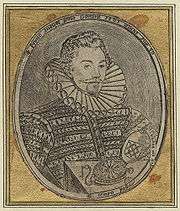Thomas Cockson
Thomas Cockson, or Coxon (bap. 1569[2] – fl. 1609-30 or 1636[1] – 1641[2]), was one of the earliest English engravers. He left a large number of portraits engraved entirely with the graver in a neatly and finished manner.[3] His first and most recognizable work is one for John Harington's version of Ariosto's Orlando Furioso and his latest, one depicting musketeers and pike men, which depicts on either side the coats of arms of various captains of the time.[4]
Thomas Cockson | |
|---|---|
 Sir John Harington, possibly engraved by Thomas Cockson in 1591.[1] | |
| Born | Thomas Cockson |
| Nationality | English |
| Other names | Thomas Coxson |
| Occupation | Engraver |
| Known for | John Harrington's translation of Ariosto's Orlando Furioso. |
Engravings
Among his works are James I, sitting in parliament,[5] Princess Elizabeth, daughter of James I,[5] Charles I sitting in parliament,[5] Charles Howard, Earl of Nottingham, on horseback, George Clifford, Earl of Cumberland, on horseback,[5] Louis XIII,[5] Marie de Médicis,[5] Mathias I, Emperor of Germany,[5] Demetrius, Emperor of Russia,[5] Concini, Marquis d'Ancre (1617),[5] Henri Bourbon, Prince de Condé,[5] Francis White, Dean of Carlisle (1624),[5] Samuel Daniel, the Court Poet (1609),[6] John Taylor, the Water Poet (title-page to his poems, 1630),[6] Thomas Coryat,[5] and many others.
He also engraved the frontispiece to John Harington's translation of Ariosto's Orlando Furioso in 1591, a plate called The Revells of Christendome of 1609, which is a satirical print representing James I, Henry IV of France, Prince Maurice (Stadholder), and Christian IV of Denmark playing cards and backgammon against the Pope and his ecclesiastical brethren,[4] some sea pieces with shipping, and in 1636 a large folding plate with explanatory letterpress of various postures for musketeers and pike men, invented by a certain Lieutenant Clarke.[6]
Thomas Cockson often signed his prints with his initials interlaced; hence it is difficult to distinguish them from those of Thomas Cross or Thomas Cecil (1630), who each used a similar monogram.[7]
See also
References
| Wikimedia Commons has media related to Thomas Cockson. |
| Wikisource has original text related to this article: |
- J. J. Jusserand (May 2010). The English Novel in the Time of Shakespeare. p. 13. ISBN 978-1-4068-6797-8.
- Oxford Dictionary of National Biography (2004). "Thomas Cockson". 1. Oxford DNB. doi:10.1093/ref:odnb/5791. Cite journal requires
|journal=(help) - Joseph Strutt, J. Davis (1785). A biographical dictionary: containing an historical account of all the Engravers, from the earliest period of the art of engraving to the present time, and a short list of their most esteemed works. London: J. Davis. pp. 208–209.
Thomas Cockson.
- Gary Taylor, John Lavagnino (19 December 2007). Thomas Middleton: The Collected Works and Companion Two Volume Set. p. 242. ISBN 978-0-19-922588-0.
- Hind, Arthur Mayger. Engraving in england in the sizteenth & seventeenth centuries: A descriptive catalogue with introductions. pp. ixx–xx.
- Salaman, Malcolm C. (1 April 2005). The Old Engravers of England in Their Relation to Contemporary Life and Art 1540 to 1800. p. 11. ISBN 978-1-4179-5119-2.
- Cust, Lionel Henry (1887). . In Stephen, Leslie (ed.). Dictionary of National Biography. 11. London: Smith, Elder & Co. p. 202.